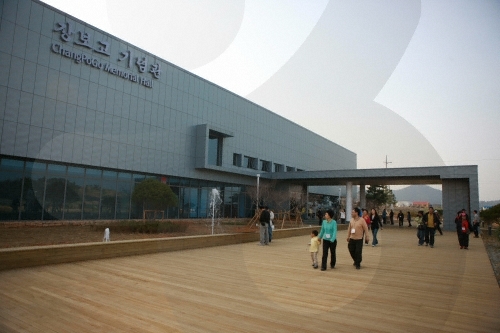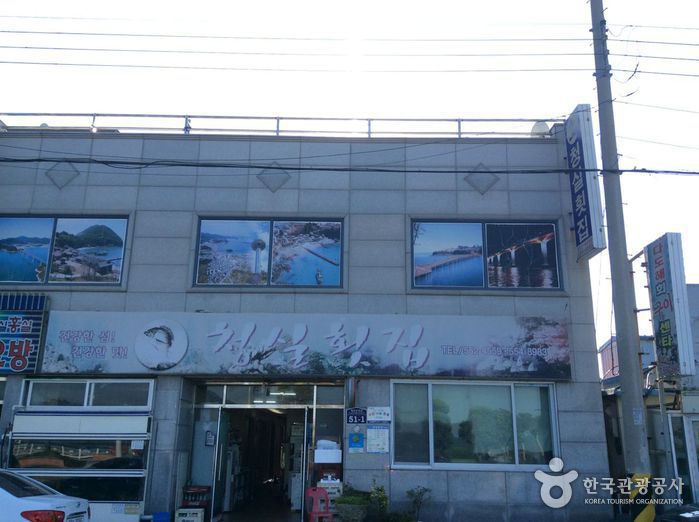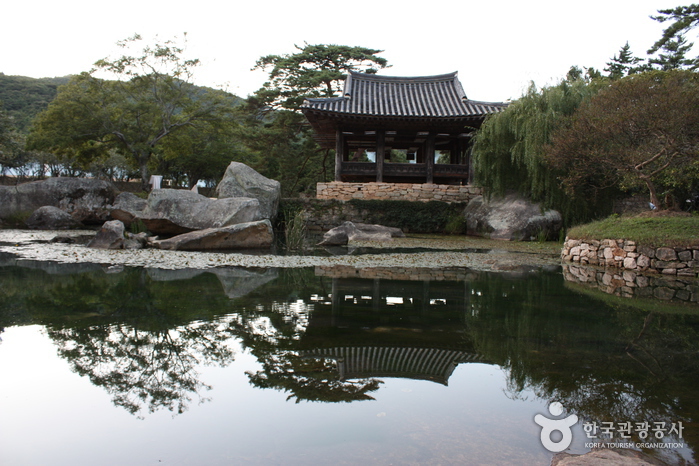Wando Jeongdo-ri Gugyedeung Pebble Beach (완도 정도리 구계등)
13.1Km 33718 2024-02-20
152-1 Jeongdo-ri, Wando-eup, Wando-gun, Jeollanam-do
Gugyedeung Pebble Beach is the area near in Wando Port. The rounded pebbles, such as those found at Gugyedeung Pebble Beach, Jeongdo-ri, have been smoothed and rounded by waves over tens of thousands of years. The unique sound of waves crashing against the pebbles is like a song, and the harmony between the sea and forest paths is beautiful, attracting many travelers.
Haemaru healingsoup [Korea Quality] / 해마루 힐링숲 [한국관광 품질인증]
13.9Km 5747 2020-12-12
108-35, Donghae-gil Bukpyeong-myeon, Haenam-gun, Jeollanam-do
+82-10-2332-6303
'Haemaru Healing Forest is a guesthouse situated at the foot of Duryunsan Mountain, Haenam in front of Wondo Beach and surrounded by a cypress grove. The mountain, cypress grove, and beach are all visible from the main floored hall room. For this reason, many of the guests who stayed here say that the picturesque view seems to change day by day. The town where the guesthouse is located is specially designed as a 'hanok village,' consisting mostly of traditional Korean houses of Jeollanam-do. It is also widely known as 'Haenam Kimchi Village' because of their famous cabbages, which are grown in the natural environment and are used to make kimchi. Specifically, there are three villages in this area: 'Green Experience Village,' 'Farm Stay Village,' and 'Resort Village.' There is a public swimming pool in the area managed by the villagers and is very popular among visitors, with ticket sales reaching KRW 100,000,000 a year. One of the advantages of staying at this guesthouse is that it’s within a one-hour ride to a number of popular nature destinations such as Wando Cheongsando Island, Gangjin Dasan Chodang, Jangheung Cheongwansan Mountain, Woodland, and Yeongam Wolchunsan Mountain. Haenam is known as one of the best regions of Korea for enjoying the famous Jeolla-do cuisine, so visitors to Haenam are advised to try the local food. The villagers built these traditional Korean guesthouses so that their visitors can have a day of relaxation in nature, away from their hectic city life. With this mind, they used natural pinewood and red clay from Gangwon-do to build authentic traditional Korean houses and utilized traditional Korean tiles from Goryeong. The name 'Haemaru Healing Forest' was given by the owner of the guesthouse, with the subtitle 'A place where you can tell your story.' The guesthouse buildings are in 'ㄱ' shape. The main building, called 'anchae' in Korean, has floor area of 72m², which is big enough for up to 25 people. There are two rooms, a large living room, and a kitchen in this building. The rooms are furnished with sofa, television, air conditioner, refrigerator, and table just like an ordinary home so that guests can feel at home during their stay. The 'bakkatchae,' or 'detached house,' is a single room with capacity of 6 and is furnished with air conditioner and bathroom. The guesthouse is owned by a couple who still work in Seoul and need to travel back and forth between Seoul and Haenam frequently. They're both nature lovers, so their most favorite place in the house is the kitchen garden where they cultivate their own organic lettuce, perilla leaves, and chili peppers. The kitchen garden is open to guests who want to try the homegrown organic vegetables. Various experience programs are offered here as well, such as yunnori, dadeumi, jwibulnori, and kimchi making. Jwibulnori is a traditional Korean game played on the eve of Daeboreum or First Full Moon Day, where people burn dry grass on the ridges of rice paddies and fields and others spin cans of flames attached to the end of a stick or a sling. For safety reasons, this game is played with the consent and participation of the villagers, so be sure to ask the owner of the guesthouse when the game is played. It’s free for groups of more than 10 people. As for the kimchi-making class, it is offered by the guesthouse owner's younger brother and sister-in-law who live and run a kimchi factory in the village. They will teach you how to make kimchi, step-by-step, start to end. The kimchi-making class is a paid program, so be sure to ask the guesthouse owner how much and when the class is held.
Chang Po Go Memorial Hall (장보고기념관)
14.9Km 22212 2021-03-12
1455, Cheonghaejin-ro, Wando-gun, Jeollanam-do
+82-61-550-6930
The Chang Po Go Memorial Hall was constructed to celebrate the achievements and maritime pioneering spirit of Chang Po Go. The hall is an educational tourism space focusing on historical culture. The permanent exhibition hall is divided into four zones that display the life of Chang Po Go.
Koner Residence Hotel[Korea Quality] / 코너레지던스호텔[한국관광 품질인증]
16.0Km 0 2023-06-10
179 , Gaepo-ro, Wando-gun, Jeollanam-do
+82-61-555-0179
Koner Residence Hotel is located in Wando-gun, Jeollanam-do, approximately 8 minutes by foot from Wando Public Bus Terminal and 5 minutes by car from Wando Port, making transportation convenient. Different types of rooms are available, including Standard, Deluxe, Suite, Royal, General, and Multiple Layers. Each room is equipped with an induction cooktop and microwave, as well as a washing machine and air purifier. Koner 179 Cafe & Dessert can be found on the first floor of the hotel.
Cheongsil Hoetjib (청실횟집)
16.2Km 27279 2024-02-20
51-1 Haebyeongongwon-ro, Wando-eup, Wando-gun, Jeollanam-do
Cheongsil Hoetjib is a restaurant that offers various dishes made with freshly caught seafood from the waters in front of Wando. Its signature dish is the jayeonsan hwareo hoe (sliced raw wild fish) made with locally caught fish. Samchi hoe (sliced raw spotted mackerel) is particularly famous, and sliced raw fish dishes featuring sea bream, sea bass, and rockfish are also consistently popular. One delicacy is placing a piece of samchi hoe on top of a piece of aged kimchi on a bed of larva, then wrapping and enjoying it together.
Nohwado Island (노화도)
16.3Km 5710 2022-06-20
813, Nohwa-ro, Wando-gun, Jeollanam-do
+82-61-550-5152
Nohwado Island, a stopping point en route to Bogildo Island, is well known for its abalone and mussel production. The island produces 70% of Korea's cultivated abalone, and offers seashell harvesting programs. Other attractions include Nohwa Red Sea, Geuknaksa Temple, and the 450-year-old hackberry tree.
Daeheungsa Temple [UNESCO World Heritage] (대흥사[유네스코 세계문화유산])
17.5Km 14935 2020-12-22
400, Daeheungsa-gil, Haenam-gun, Jeollanam-do
+82-61-534-5502
Daehuengsa Temple is told to have been built during the time of King Seong of the Baekje period by Adohwasang, a Silla Monk and the site was the restoration of Samjae bulipjicheo of Buddhist culture, which protects Samjae, the three disasters of one’s life.
Pyochungsa and Iljiam Tea Garden display writings and traces of the prominent men of the time such as Chusa Kim Jeong-hui and Chouiseonsa Buddhist monk. Inside the temple, Daeungbojeon, Chimgyeru, Myeongbujeon, Eungjindang, Cheonbuljeon, Cheonbulsang, Pyochungsa, Daegwangmyeongjeon, Iljiam, Bungmireugam, and Seongbo Museum are situated.
The Rock-carved Seated Buddha at North Mireugam Hermitage of Daeheungsa Temple, Haenam (National Treasure No. 308) and Bronze Bell with Inscription of Tapsansa Temple (Treasure No. 88) are preserved as well as various cultural assets and fables such as Budojeon, and Stupa Courtyard, the largest in Korea.
Wando Tower (완도타워)
17.8Km 33826 2021-09-04
330, Jangbogo-daero, Wando-gun, Jeollanam-do
+82-61-550-6964
Wando Tower is an impressive 76 meters in x_height, and stands at the top of Dongmangsan Mountain in Wando. The area includes a plaza, walking path, resting area, and offers a fantastic view of the sunrise, sunset, and city at night.
The tower also overlooks several islands including Cheongsando Island, Bogildo Island, Nohwado Island, Sinjido Island and Gogeumdo Island. On clear days with high visibility, some islands like Jeju Island and Geomundo Island are also within sight. Located next to the tower is bongsudae (a fire signal beacon) and a walking path through Dongmangsan Mountain.
Seoladawon [Korea Quality] / 설아다원 [한국관광 품질인증]
17.9Km 10535 2023-10-26
153-21 , Samseong-gil, Haenam-gun, Jeollanam-do
+82-61-533-3083
Seola Dawon is a hanok stay at the foot of Mt Duryun in Haenam, Jeollanam-do. It began as a tea plantation whose owner wanted to pass on his love for traditional tea culture to the next generation. Many visitors came and they needed accomodation, so the owner built a small stone guest room. Now there are 8 guestrooms, including a clay house, a timber frame house, and an earthbag house; while the work of promoting tea cultivation and culture continue.
Bogildo Island Seyeonjeong Pavilion (보길도 세연정)
18.0Km 21313 2021-12-23
57, Buhwang-gil, Wando-gun, Jeollanam-do
+82-61-550-5761
Yun Seon-do (1587~1671), a non-military civil administrator and poet in the mid Joseon dynasty, could hardly contain his anger after hearing the news that the king had surrendered during the Byeongjahoran War (Chinese invasion of Korea in 1636). Following the events, he decided to live in seclusion by moving to Jeju Island. However, on the way to Jeju, he came across Bogildo Island and he was so inspired by its beauty that he ended up settling down on Bogildo instead.
For the following 13 years, he composed great poems such as "Eobusasisa (Fisherman's Song for Four Seasons)." Some of the mountain peaks and rocks named by him still remain on the island.
Seyeonjeong Pavilion was built by Yun Seondo and this is the birthplace of his literary works. On clear days, he would come to the pavilion with his family and let singers sing his verses.
Bogildo Island embraces both the Eastern outlook on nature and Neo-Confucianism ideology. While going around the island, visitors will get some semblance of how Yun Seondo harmonized man and nature through the combination of the island's natural and the man-made features.

![Haemaru healingsoup [Korea Quality] / 해마루 힐링숲 [한국관광 품질인증]](http://tong.visitkorea.or.kr/cms/resource/35/2049835_image2_1.jpg)

![Koner Residence Hotel[Korea Quality] / 코너레지던스호텔[한국관광 품질인증]](http://tong.visitkorea.or.kr/cms/resource/92/2808592_image2_1.png)

![Daeheungsa Temple [UNESCO World Heritage] (대흥사[유네스코 세계문화유산])](http://tong.visitkorea.or.kr/cms/resource/09/1929609_image2_1.jpg)
![Seoladawon [Korea Quality] / 설아다원 [한국관광 품질인증]](http://tong.visitkorea.or.kr/cms/resource/25/3021525_image2_1.jpg)

 English
English
 한국어
한국어 日本語
日本語 中文(简体)
中文(简体) Deutsch
Deutsch Français
Français Español
Español Русский
Русский